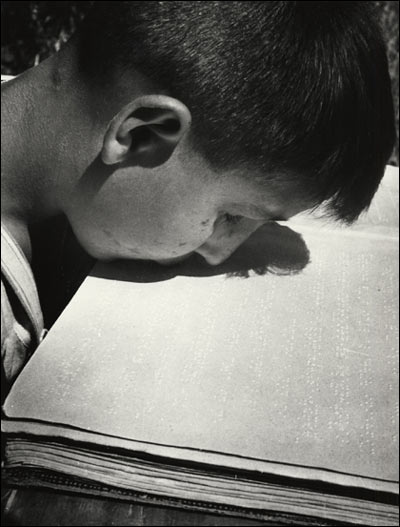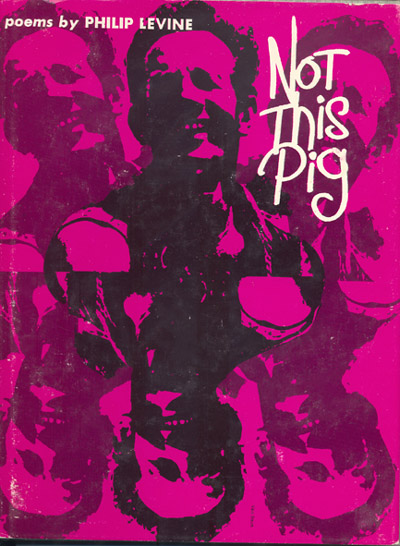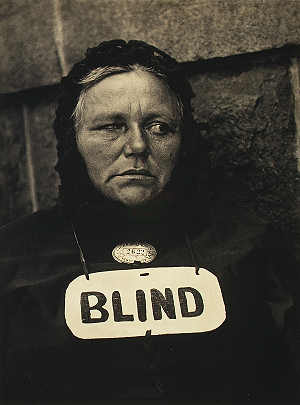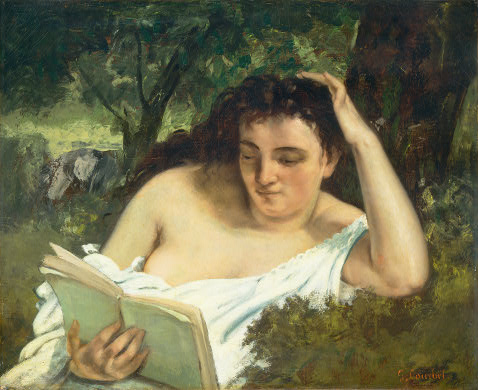
David Seymour. “Blind Boy Reading With His Lips”. 1948. Corcoran Gallery of Art, Washington, D.C.
This photograph could have been framed in a different way to milk much more pathos from it. The blind boy has no hands or arms. A civilian casualty of World War II, he was photographed at an Italian school where he learned to read braille with his lips.
David Seymour was better known by his French pen name, Chim. He was a pioneering photojournalist in the 1930s and later founded the Magnum Photos agency along with Robert Capa and Henri Cartier-Brasson. Chim was known for his humanity and ability to establish the trust of his subjects, particularly the children he photographed. In 1948 UNICEF commissioned him to document the impact of war on children in Europe. This photo comes from that project.
This type of photojournalism is what I grew up with as a kid looking at Life magazine. It reflects a kind of socially engaged photography that fit into larger social projects — think of Edward Steichen’s The Family of Man. It expresses commitment.
Some people look at a photo like this and read into it a hero narrative. Here is a courageous disabled person who has an indomitable will to overcome adversity. I don’t see it quite that way. I believe the qualities of heroism and will to overcome are hard prescriptions to fill. That kind of hero narrative places too much responsibility on the individual rather than the individual in relation to society, which is a more authentic reflection of what the process of disability is.
Nonetheless, I look at this photograph and I still get charged by it. It means a lot to me. In the vocabulary of my visual rhetoric, it represents the process of making adaptations and negotiating accommodations. I truly believe that people with disabilities do this every day. Those adaptations and accommodations are a significant form of cultural production. This is one of my deepest convictions in a life of living with a disability, a life of working as a disability rights activist. Accessibility is creative work. It is not a band-aid or a pathway, something that must be done before one can have culture or consume culture. It is part of culture itself, in the same way that disability is part of the natural spectrum of the human condition.
 Curiosity & the Blind Photographer: Introduction | 1. Paul Strand | 2. David Seymour | 3. Henry Butler | Complete talk | Follow the blog thread This talk was presented first at MiT5 in April 2007. Then it was titled Re-Imagining Accessibility in Participatory Culture.
Curiosity & the Blind Photographer: Introduction | 1. Paul Strand | 2. David Seymour | 3. Henry Butler | Complete talk | Follow the blog thread This talk was presented first at MiT5 in April 2007. Then it was titled Re-Imagining Accessibility in Participatory Culture.
![gustave_caillebotte_paris_street_rainy_day Gustave Caillebotte. Paris Street, Rainy Day (La Place de l’Europe, temps de pluie). 1877. Oil on canvas. Art Institute of Chicago. [Source: Wikimedia Commons]](../../../../wp-content/uploads/2009/02/gustave_caillebotte_paris_street_rainy_day_1877_wiki.jpg)
![Fog at Isle Royale [Source: wildmengoneborneo.com] Fog at Isle Royale [Source: wildmengoneborneo.com]](../../../../wp-content/uploads/2008/04/isle_royale_fog.jpg)
 If there is an emerging genetic underclass, I could run for class president or class clown. Read more in
If there is an emerging genetic underclass, I could run for class president or class clown. Read more in 
